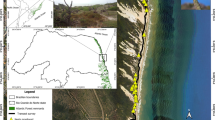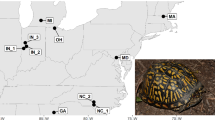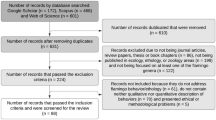Abstract
Theoretical and empirical studies suggest that the age of first reproduction (the age at which reproduction begins) can have a substantial influence on population dynamics and individual fitness. Using complete survival and reproductive histories of 428 female yellow-bellied marmots (Marmota flaviventris) from a 40-year study (1962–2001), we investigated causes and fitness consequences of delayed maturity. Most females (86%) died without reproducing. The age of first reproduction of females that survived to reproduce at least once (n=60) ranged from 2 to 6 years. Females maturing later did not have a larger lifetime number of successful reproductive events or offspring production, nor did they experience improved survival. Females reproducing earlier had a higher fitness than those that delayed maturity. These results suggest that the net cost of early maturity was less than fitness benefits associated with early onset of reproduction, and that age of first reproduction in our study population is under substantial directional selection favoring early maturity. We conclude that female yellow-bellied marmots delay onset of reproduction not because of fitness benefits of foregoing reproduction at an earlier age, but due to the social suppression of reproduction by older, reproductive females, which enhances their own fitness to the detriment of the fitness of young females. Our results indicate that female yellow-bellied marmots that survive to reproduce may act to increase their own direct fitness, and that social suppression of reproduction of young females is a part of that strategy.



Similar content being viewed by others
References
Armitage KB (1986a) Individuality, social behavior, and reproductive success in yellow-bellied marmots. Ecology 67:1186–1193
Armitage KB (1986b) Marmot polygyny revisited: determinants of male and female reproductive strategies. In: Rubenstein DI, Wrangham RW (eds) Ecological aspects of social evolution. Princeton University Press, Princeton, pp 303–331
Armitage KB (1991) Social and population dynamics of yellow-bellied marmots—results from long-term research. Annu Rev Ecol Syst 22:379–407
Armitage KB (1992) Social organization and fitness strategies of marmots. 1st International Symposium on Alpine Marmot 1:89–94
Armitage KB (1994) Unusual mortality in a yellow-bellied marmot population. In: Rumiantsev VYu (ed) Actual problems of marmots investigation. ABF Publishing, Moscow, pp 5–13
Armitage KB (1996) Social dynamics, kinship, and population dynamics of marmots. In: Le Berre M, Ramousse R, Le Guelte L (eds) Biodiversity in marmots. International Marmot Network, Moscow-Lyon, pp 113–128
Armitage KB (1998) Reproductive strategies of yellow-bellied marmots: energy conservation and differences between the sexes. J Mammal 79:85–393
Armitage KB (2002) Social dynamics of yellow-bellied marmots: strategies for evolutionary success. In: Armitage KB, Rumiantsev VYu (eds) Holarctic marmots as a factor of biodiversity. ABF Publishing, Moscow, pp 9–21
Armitage KB (2003a) Recovery of a yellow-bellied marmot population following a weather-induced decline. In: Ramousse R, Allaine D, LeBerre M (eds) Adaptive strategies and diversity in marmots. International Marmot Network, Lyon (in press)
Armitage KB (2003b) Reproductive competition in female yellow-bellied marmots. In: Ramousse R, Allaine D, LeBerre M (eds) Adaptive strategies and diversity in marmots. International Marmot Network, Lyon (in press)
Armitage KB, Schwartz OA (2000) Social enhancement of fitness in yellow-bellied marmots. Proc Natl Acad Sci USA 97:12149–12152
Avilés L, Tufiño P (1998) Colony size and individual fitness in the social spider Anelosimus eximius. Am Nat 152:403–418
Batzli GO, Getz LL, Hurley SS (1977) Suppression of female reproductive maturation in microtine rodents by social factors. J Mammal 58:583–591
Bell G (1980) The costs of reproduction and their consequences. Am Nat 116:45–76
Bennett NC (1994) Reproductive suppression in social Cryptomys damarensis colonies—a lifetime of socially-induced sterility in males and females (Rodentia, Bathyergidae). J Zool (Lond) 234:25–39
Bennett NC, Faulkes CG, Molteno AJ (1996) Reproductive suppression in subordinate, non-breeding female Damaraland mole-rats: two components to a lifetime of socially induced infertility. Proc R Soc Lond Ser B 263:1599–1603
Brommer JE, Pietiainen H, Kolunen H (1998) The effect of age at first breeding on Ural owl lifetime reproductive success and fitness under cyclic food conditions. J Anim Ecol 67:359–369
Brommer JE, Merilä J, Kokko H (2002) Reproductive timing and individual fitness. Ecol Lett 5:802–810
Clarke FM, Miethe GH, Bennett NC (2001) Reproductive suppression in female Damaraland mole-rats Cryptomys damarensis: dominant control or self-restraint? Proc R Soc Lond Ser B 268:899–909
Clutton-Brock TH (1988) Reproductive success. University of Chicago Press, Chicago
Cole L (1954) The population consequences of life-history phenomena. Q Rev Biol 29:103–137
Dobson FS, Oli MK (2001) The demographic basis of population regulation in Columbian ground squirrels. Am Nat 158:236–247
Drickamer LC (1982) Delay and acceleration of puberty in female mice by urinary chemosignals from other females. Dev Psychobiol 15:433–446
Faulkes CG, Abbot DH, Lidell CE, George LM, Jarvis JUM (1991) Hormonal and behavioral aspects of reproductive suppression in female naked mole rats Heterocephalus glaber. In: Sherman PW, Jarvis JUM, Alexander RD (eds) The biology of naked mole rats. Princeton University Press, New York
Frase BA, Hoffmann RS (1980) Marmota flaviventris. Mamm Species 135:1–8
Gilbert BS, Krebs CJ (1991) Population dynamics of Clethrionomys and Peromyscus in Southwestern Yukon 1973–1989. Holarct Ecol 14:250–259
Grafen A (1988) On the uses of data on lifetime reproductive success. In: Clutton-Brock TH (ed) Reproductive success. University of Chicago Press, Chicago, pp 454–471
Hamilton WD (1971) Altruism and related phenomena, mainly in social insects. Annu Rev Ecol Syst 3:192–232
Hirshfield MF, Tinkle DW (1975) Natural selection and the evolution of reproductive effort. Proc Natl Acad Sci USA 72:2227–2231
Jong G de (1994) The fitness of fitness concepts and the description of natural selection. Q Rev Biol 69:3–29
Käär P, Jokela J (1998) Natural selection on age-specific fertilities in human females: comparison of individual-level fitness measures. Proc R Soc Lond Ser B 265:2415–2420
Lande R, Arnold SJ (1983) The measurement of selection on correlated characters. Evolution 37:1210–1226
Law R (1979) Ecological determinants of the evolution of life histories. In: Anderson RM, Turner BD (eds) Population dynamics. Blackwell, Oxford, pp 81–103
Lewontin RC (1965) Selection for colonizing ability. In: Baker HG, Stebbins GL (eds) The genetics of colonizing species. Academic Press, New York, pp 79–94
Link WA, Cooch EG, Cam E (2002) Model-based estimation of individual fitness. J Appl Stat 29:207–224
McGraw JB, Caswell H (1996) Estimation of individual fitness from life history data. Am Nat 147:47–64
McGuire B, Getz LL, Oli MK (2002) Fitness consequences of communal nesting in prairie voles (Microtus ochrogaster): influence of group size and composition. Anim Behav 64:645–654
Oli MK (1999) The Chitty effect: a consequence of dynamic energy allocation in a fluctuating environment. Theor Popul Biol 56:293–300
Oli MK (2003) Hamilton goes empirical: estimation of inclusive fitness from life-history data. Proc R Soc Lond Ser B 270:307–311
Oli MK, Dobson FS (2003) The relative importance of life-history variables to population growth rate: Cole's prediction revisited. Am Nat 161:422–440
Oli MK, Hepp GR, Kennamer RA (2002) Fitness consequences of delayed maturity in female wood ducks. Evol Ecol Res 4:563–576
Partridge L, Harvey PH (1988) The ecological context of life history evolution. Science 241:1449–1455
Pyle P, Nur N, Sydeman J, Emslie SD (1997) Cost of reproduction and the evolution of deferred breeding in the western gull. Behav Ecol 8:140–147
Reznick D (1985) Costs of reproduction: an evaluation of the empirical evidence. Oikos 44:257–267
Roff DA (1992) The evolution of life histories. Chapman & Hall, New York
Saitoh T (1981) Control of female maturation in high density populations of the red backed vole, Clethrionomys rufocanus bedfordiae. J Anim Ecol 50:79–87
SAS Institute (1999) SAS/STAT user's guide, version 8. SAS Institute, Cary, N.C.
Schwartz OA, Armitage KB (2002) Correlations between weather factors and life-history traits of yellow-bellied marmots. In: Armitage KB, Rumiantsev VYu (eds) Holarctic marmots as a factor of biodiversity. ABF Publishing, Moscow, pp 345–351
Schwartz OA, Armitage KB, Van Vuren D (1998) A 32-year demography of yellow-bellied marmots (Marmota flaviventris). J Zool (Lond) 246:337–346
Stearns SC (1989) Trade-offs in life history evolution. Funct Ecol 3:259–268
Stearns SC (1992) The evolution of life histories. Oxford University Press, Oxford
Stearns SC, Crandall RE (1981) Quantitative predictions of delayed maturity. Evolution 35:455–463
Svendsen GE (1974) Behavioral and environmental factors in the spatial distribution and population dynamics of a yellow-bellied marmot population. Ecology 55:760–771
Treves A (2001) Reproductive consequences of variation in the composition of howler monkey (Aloutta spp.) groups. Behav Ecol Sociobiol 50:61–71
Vandenbergh JG (1994) Pheromones and reproduction. In: Knobil E, Neill JD (eds) The physiology of reproduction. Raven Press, New York, pp 343-359
Van Vuren D, Armitage KB (1994a) Survival of dispersing and philopatric yellow-bellied marmots—what is the cost of dispersal? Oikos 69:179–181
Van Vuren D, Armitage KB (1994b) Reproductive success of colonial and noncolonial female yellow-bellied marmots (Marmota flaviventris). J Mammal 75:950–955
Wasser SK, Barash DP (1983) Reproductive suppression among female mammals: implications for biomedicine and sexual selection theory. Q Rev Biol 58:513–538
Waterman JM (2002) Delayed maturity, group fission and limits of group size in female cape ground squirrels (Sciuridae: Xerus inauris). J Zool (Lond) 256:113–120
Woods BC (2001) Diet and hibernation of yellow-bellied marmots: why are marmots so fat? PhD dissertation, University of Kansas, Lawrence
Acknowledgements
We thank several graduate students and technicians: this work would not have been possible without their dedicated field work. F.S. Dobson, R.A. Moen, and two anonymous reviewers critically reviewed the manuscript and provided many insightful comments. This research was supported in part by the Florida Agricultural Experiment Station, and by National Science Foundation grants G16354, GB-1980, GB-6123, GB-32494, BMS74-21193, DEB78-07327, BSR-8121231, BSR8614690, BSR-9006772 (to KBA), and DEB-0224953 (to MKO), and approved for publication as Journal Series No. R-09210.
Author information
Authors and Affiliations
Corresponding author
Rights and permissions
About this article
Cite this article
Oli, M.K., Armitage, K.B. Sociality and individual fitness in yellow-bellied marmots: insights from a long-term study (1962–2001). Oecologia 136, 543–550 (2003). https://doi.org/10.1007/s00442-003-1291-7
Received:
Accepted:
Published:
Issue Date:
DOI: https://doi.org/10.1007/s00442-003-1291-7




